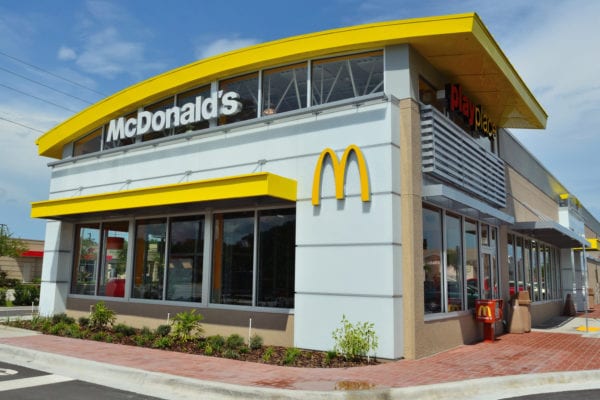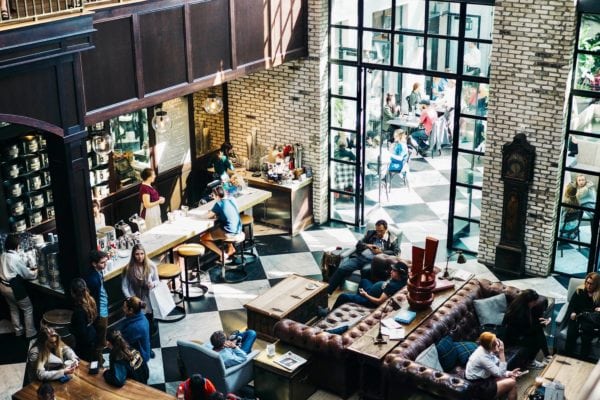Skift Take
One-year-old startup Luckin' Coffee is making huge gains in China with an easy, straightforward strategy: sell cheaper coffee than Starbucks and be consistently faster on pick-up and delivery.
— Erika Adams
Luckin Coffee, a Chinese startup that’s banking on selling cappuccinos to on-the-go office workers, is spending millions of dollars a year opening outlets to unseat Starbucks Corp. as the top java seller in the country.
Launched about a year ago, the local challenger is confident it’s got a winning model: small coffee outlets that will outnumber Starbucks cafes by year’s end, an app that rushes out deliveries in about 18 minutes and lots of steep discounts. Chasing the entrenched rival, it’s burning through $130 million a year, according to the Xiamen-based company on China’s southeast coast.
“China is Starbucks’ best and most profitable market now, but it took them nine years of making huge losses,’’ said Chief Strategy Officer Reinout Schakel in an interview in Beijing this week. “We will be faster than that.’’ Luckin’s success so far is putting pressure on Starbucks, which until now had no meaningful challenger and dominated the market with more than 50 percent share. The companies are employing vastly different approaches in their claims to the $3.2 billion retail coffee market that is Starbucks’ fastest-growing and second-biggest. That competition is likely to heat up with China’s economic slowdown.
Questions abound whether Luckin can parlay customer discounts and media hype into as powerful a brand as its rival. The Seattle-based behemoth has lately dialed down its ambition in China, even as it still targets a tripling of revenue by 2022. Starbucks reported last month that comparable sales growth could be as low as 1 percent over the long term, sparking concern that competition and cannibalization are taking their toll.
Currently valued at $2.2 billion and backed by investors including Singapore’s sovereign wealth fund GIC and China International Capital Corp., Luckin has emphasized convenience in its business model, betting that Chinese office workers would rather have ease of access over premium frills — and pay about a third less for a cup of Luckin joe.
While the global rival prides itself on warmth and service embodied in cafes styled as a “third space” between home and office, Luckin is about efficiency: its outlets are cashless and customers are meant to be able to get their coffee without ever speaking to anyone.
The outlets, in or near office buildings, are designed for fast pick-up and delivery — and exploits a competitive edge where Starbucks has been late to the game. Despite Chinese consumers’ reliance on food delivery, Starbucks only launched delivery in partnership with Alibaba Group Holding in August.
“If I was an investor in Starbucks, I would also invest in Luckin to hedge my bets,’’ said Schakel, who is also chief financial officer.
Luckin has made headlines for setting a target of 4,500 stores this year, most no larger than a studio apartment rather than sit down cafes. Still, they would outstrip Starbucks’ count of about 3,600. For its part, Starbucks is also setting up small, delivery-focused kitchens in Alibaba’s Freshippo supermarkets and more than 2,000 of its stores are now equipped for delivery.
Luckin, also known by its Chinese name Ruixing, faces an uphill race against a global competitor who’s clocked 20 years in the world’s second-biggest market. The local upstart is reliant on discounts and promotions to lure customers, which may create an unsustainable spike in demand. China’s landscape is littered with start-ups whose cash-burn models and flashy press never translated to profitability.
Added to that, the brand association, taste preference and research and development capabilities that Starbucks brings to the table are much higher barriers for Luckin to overcome, said OC&C Strategy Consultants partner Jack Chuang.
“Luckin is applying an Internet mindset where if they become large enough then they become a ‘habit’ for consumers, but the challenge is that for food and beverages, it’s very hard to create a habit on a heavily subsidized proposition,” Chuang said.
Schakel said that the company is well-funded and “not immediately focused on capital raising’’ despite reports that it’s preparing for an initial public offering in Hong Kong. He said that more partnerships, like the one with internet giant Tencent Holdings Ltd. as well as foreign food and beverage chains in China, are on the cards.
Seeking to shift focus from its competition with Starbucks, Schakel said that China has enough potential to sustain more than one chain. Chinese consumers currently drink just 4 to 5 cups per capita, compared to about 300 cups in countries like Taiwan, Hong Kong and South Korea, he said.
Even as it mounts its challenge, Luckin still looks to Starbucks to lead the way with its considerably larger resources in promoting coffee consumption in China, a traditionally tea-drinking country. Luckin will focus on expanding in tier 1 and 2 cities, while waiting to see how Starbucks fares deeper in rural China, he said.
“Of course we are competitors, but ultimately we both want the market to grow,’’ he said.
—With assistance from Tom Mackenzie and Daniela Wei
This article was written by Bloomberg News from Bloomberg and was legally licensed through the NewsCred publisher network. Please direct all licensing questions to [email protected].
![]()



